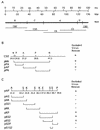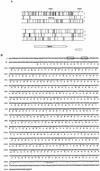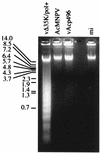Isolation of an apoptosis suppressor gene of the Spodoptera littoralis nucleopolyhedrovirus
- PMID: 9882332
- PMCID: PMC103951
- DOI: 10.1128/JVI.73.2.1278-1285.1999
Isolation of an apoptosis suppressor gene of the Spodoptera littoralis nucleopolyhedrovirus
Abstract
Spodoptera frugiperda SF9 cells infected with mutants of the Autographa californica nucleopolyhedrovirus (AcMNPV) which lack a functional p35 gene undergo apoptosis, aborting the viral infection. The Spodoptera littoralis nucleopolyhedrovirus (SlNPV) was able to suppress apoptosis triggered by vDeltaP35K/pol+, an AcMNPV p35 null mutant. To identify the putative apoptotic suppressor gene of SlNPV, overlapping cosmid clones representing the entire SlNPV genome were individually cotransfected along with genomic DNA of vDeltaP35K/pol+. Using this complementation assay, we isolated a SlNPV DNA fragment that was able to rescue the vDeltaP35K/pol+ infection in SF9 cells. By further subcloning and rescue, we identified a novel SlNPV gene, Slp49. The Slp49 sequence predicted a 49-kDa polypeptide with about 48.8% identity to the AcMNPV apoptotic suppressor P35. SLP49 displays a potential recognition site, TVTDG, for cleavage by death caspases. Recombinant AcMNPVs deficient in p35 bearing the Slp49 gene did not induce apoptosis and showed successful productive infections in SF9 cells, indicating that Slp49 is a functional homologue of p35. A 1.5-kbp Slp49-specific transcript was identified in SF9 cells infected with SlNPV or with vAc496, a vDeltaP35K/pol+-recombinant bearing Slp49. The discovery of Slp49 contributes to the identification of important functional motifs conserved in p35-like apoptotic suppressors and to the future isolation of p35-like genes from other baculoviruses.
Figures









References
-
- Ahmad M, Srinivasula S M, Wang L, Litwack G, Fernandes-Alnemri T, Almemri E S. Spodoptera frugiperda caspase-1, a novel insect death protease that cleaves the nuclear immunophilin FKBP46, is the target of the baculovirus antiapoptotic protein p35. J Biol Chem. 1997;272:1421–1424. - PubMed
-
- Ayres M D, Howard S C, Kuzio J, Lopez-Ferber M, Possee R D. The complete DNA sequence of Autographa californica nuclear polyhedrosis virus. Virology. 1994;202:586–605. - PubMed
-
- Bump N J, Hackett M, Hugunin M, Seshagiri S, Brady K, Chen P, Ferenz C, Franklin S, Ghayur T, Li P, Licari P, Mankovich J, Shi L F, Greenberg A H, Miller L K, Wong W W. Inhibition of ice family proteases by baculovirus antiapoptotic protein p35. Science. 1995;269:1885–1888. - PubMed
Publication types
MeSH terms
Substances
Associated data
- Actions
LinkOut - more resources
Full Text Sources
Other Literature Sources
Research Materials

